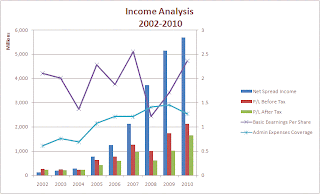About the Meezan Bank:
The Bank was incorporated in Pakistan on January 27, 1997, as a public limited company under the Companies Ordinance, 1984, and its shares are quoted on the Karachi Stock Exchange.
Registered Office
Meezan House, C25,
Estate Avenue, Site, Karachi
E-mail: info@meezanbank.com
Website
www.meezanbank.com
Key Financial and Operating data: (year ended Dec 2010)
Total Assets: 154,752,425,000
Net Assets: 11,079,991,000
No. of Ordinary Shares: 698,255,053
No. of Branches: 222
No. of Staff: 4,364
Profit or Loss per Share(Year Ended Dec 2010):2.36
Profit or Loss per Share (Half Year Ended June 2011):1.72
Market Price per Share (As of 12/9/2011): Rs 18.60 Per share
Credit Rating As of June 2011
Short Term: A1+
Long Term: AA-
Income Analysis:
The bank achieved extraordinary growth in spread income during 2003-2009. However, in 2010 the growth in spread income took a downward trend and was limited to around 10% implying higher cost of intermediation and banking activities. The basic earnings per share hovered around Rs.2 Per Share. The bank sufficiently covers its administrative expenses out of its core banking activities i.e. taking deposits and undertaking loans and investment activities.
Return and Efficiency:
Risk, Liquidity and Depth of Banking Operations:
The banks risk profile remained stable over the years 2002-2010. Its leverage ratio has increased steadily over the years. The liquidity of the bank’s asset profile is high owing to the higher proportion of liquid investments as compared to the ill-liquid loan portfolio. Greater proportion of investment in liquid asset may imply a higher level of illiquidity and risk of loan portfolio. Over the years, the bank’s ability and willingness to extend loan is reduced.

Conclusion:
Overall financial performance of the bank remained stable. The bank needs to improve capital so that it can increase its banking operation i.e. accepting deposits and extending loans. The banks efficiency and return parameters are satisfactory.


No comments :
Post a Comment